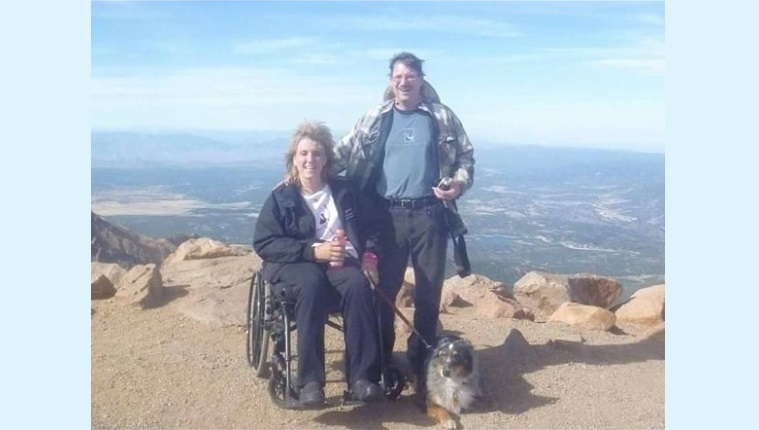Our dogs do so much for us. They provide us with unconditional love, snuggles, and happiness. But some dogs go above and beyond for their humans.
Service dogs are different from pets, therapy animals, and even emotional support animals. They provide specific services to persons with disabilities or medical conditions, and they accompany their humans in their day-to-day activities.
I had the pleasure of interviewing Lee Kriska, a service dog owner who has worn many hats over the years in the name of spreading awareness about service dogs and inspiring and helping others.

Lee has been a public speaker for the Spinal Cord Injury Association of Illinois, an animal-assisted therapy assistant, and a librarian at Summit Public Library where she brings her service dog to help read and educate kids about service animals.
Here’s what Lee had to say!
Taz & Merlot Bring Inspiration To Patients

AMANDA: Lee, I had the honor of meeting you and your service dog at the time, Merlot, at Marianjoy Rehabilitation Hospital eight years ago, during one of your many traveling service dog presentations! Merlot was a very special dog, whom patients loved.
LEE: Thank you! Yes, he was. When we worked at Advocate Christ Medical Center, Merlot and his uncle, Taz, helped patients with physical, occupational, and speech therapy. It’s still their normal therapy, but the dogs are around and interacting with them.
It started out by Taz accompanying me to a physical therapy weight-training class I was taking, myself, and everyone loved interacting with them. I began to volunteer there with Taz, and then Merlot, too, and they actually created a special job for us at the time, after meeting the dogs and seeing how much they encouraged patients.
AMANDA: That’s really sweet. Why do you think they had such an impact on patients?
LEE: All of my dogs have been very friendly and cheerful. Therapists were in awe over the transformation Merlot made, especially over angry or reluctant patients.
They’d say, “This patient was doing great because he wasn’t paying attention to how he couldn’t do it.” The patient was also excited to walk his own dog at home.
So Merlot (and Taz before him) distracted patients from their negative feelings with their own positive spirits and helped the patients to work harder, sometimes without even realizing it.
Merlot actually became even more inspiring for patients after losing his vision. I think patients were especially inspired by seeing how happy and capable Merlot was, even though he was blind.
Merlot could do everything after losing his sight that he could before; he just had to do it differently. I think that’s a great, relatable message, for patients.
Never Giving Up On A Great Dog
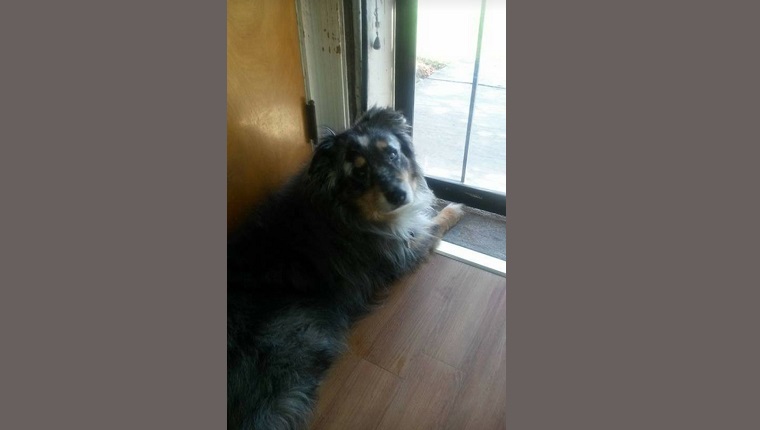
AMANDA: That is so sweet to hear. How did Merlot lose his sight?
LEE: When Merlot was six years old, he got bitten by a tick. We had no idea, but he was on Frontline, so he should’ve been okay — except that he had a hidden autoimmune disease, which canceled out the effectiveness of the medication. The autoimmune disease flared once he was bitten by the tick.
AMANDA: That must have been upsetting.
LEE: It was, and the vet advised we put him down, saying she thought he would suffer. She also said it would be dangerous for him to be my service dog without his vision.
I just couldn’t bring myself to do it. I had rehabbed, after all, so I wanted to give Merlot the same chance.
As soon as I returned Merlot to “work,” after a month off for healing, he went from depressed to happy. Retiring that young, after being an active working dog, would’ve broken his spirit.
I’m so glad I followed my instincts. He lived to be 13.5 years old, and all of those years were very happy.
AMANDA: I’m glad, too!
Taz & Merlot Come To The Rescue

AMANDA: May I ask about your disability?
LEE: I have Spinal Cord AVMs — arterial venous malformations — they’re similar to aneurisms/blood clots on the spinal cord. It’s an extremely rare condition. I’ve had them my whole life, but they didn’t pop up till I was 14 years old.
Because I was so young, I had that inspiration and determination of figuring out how to do things. Since then, I’ve worked very hard at overcoming my limitations and not being seen as disabled.
AMANDA: That’s amazing. How did Merlot and Taz come into your life?
LEE: I knew I could use help pulling my wheelchair, so I’d need a strong service dog of larger size to be able to do that. I was fortunate to have both Taz and Merlot donated to me.
The breeder who donated Taz was a professional trainer, and she helped train Merlot once a week. That breeder trained me, too, for seven months, so now I know how, too.
I raised Merlot from a puppy, and I did a lot of his training, too. It’s just a matter of practice and repetition!
What Do These Service Dogs Do?

AMANDA: What do your service dogs do for you?
LEE: The main thing I’ve always used my dogs for is mobility — basically, my dogs being able to pull me in my wheelchair. That’s why I opt for larger dogs. Obviously, they’ve got to have the strength to pull me. I don’t have them start from a standstill; I’ll push to start.
My left side is much more compromised than right. My left arm and shoulder have been through a lot. I’ve been in my chair 34 years. If I’m pushing my chair for a long time, I’ll start to feel the wear and tear on my shoulders, and I’ll just have to go home, or my arm will get completely numb.
My spinal cord disease causes nerve problems. With the dogs, I can eliminate 75 percent of that wear and tear, and I can focus the energy on transfers, etc.
I just turned 49. There are now days when distance doesn’t really matter. I can go from front door to car, and it might make me tired. It might be age/arthritis, but now, it doesn’t always take a lot to make me fatigued.
I find myself utilizing Java Beans, my current service dog, a little bit more, even going from my car in the parking lot into grocery store. Things like an uneven, wavy parking lot can make it really tiring.
Java Beans Enters The Picture
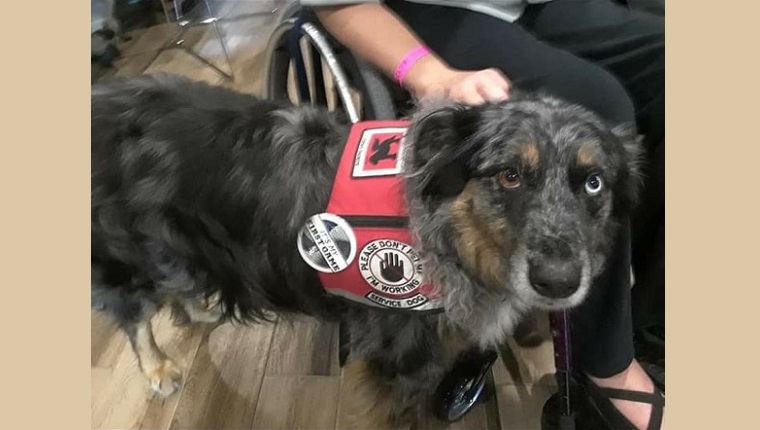
AMANDA: I’m glad Java Beans is able to help, and I’m sure he’s happy to do so. How did he come into your life?
LEE: I really wanted my next service dog to be an Australian Shepherd rescue. It was surprisingly difficult. Unfortunately, a lot of shelters didn’t think I’d be up to the task of caring for a dog, even though I had the experience and training to do so (I also live with my husband).
As fate would have it, though, Facebook recognized my search history and showed me an ad for an adorable Australian Shepherd at a rescue in Yorkville, Illinois: Jellystone Bark Rescue Ranger, based out of Yorkville Animal Hospital. The dog was originally from Kentucky. Volunteers foster all the dogs.
The rescue called me the next day and said to bring all the animals and family to do a meet-and-greet. They wanted us to come out in the next few hours because they were afraid there might be more people wanting to adopt Java Beans.
We live in Chicago, and my husband was at work, so it was quite an endeavor to get there in time. But we were determined!
Java Beans was between ten and twelve months old, a surrender from a divorce. They didn’t know much about him. He has a blue eye and a brown eye — looks like an adorable wolf! I loved him to death and thought he’d be a great dog.
AMANDA: That is so sweet!
Even Service Dogs Need To Get Along
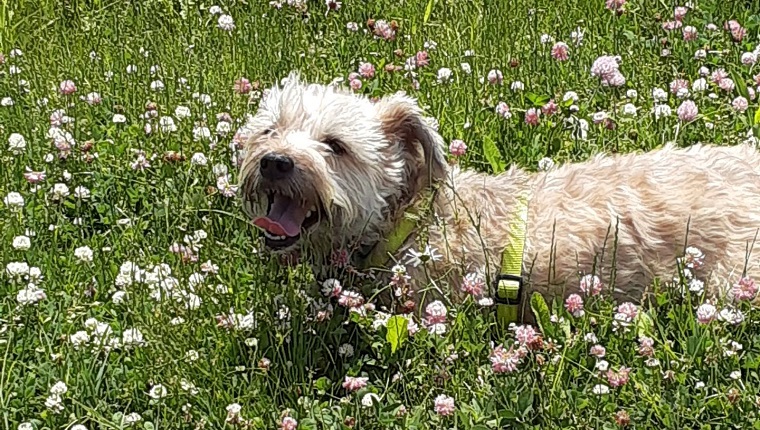
AMANDA: Were there other dogs in your home at the time?
LEE: Yes, Merlot was still around, and I had also adopted Riley from a friend, whose baby had developed a severe, sudden allergy to the dog. Riley and Java Beans were immediate friends, but Merlot was terrified of Java Beans, because he couldn’t see him.
Merlot would bump into Java Beans accidentally, Java Beans would put his paw on top of Merlot’s face, and then Merlot would snap at him, and then Java Beans would bite him. So innocent knocking into each other could turn into fights, just from misunderstanding.
I trained Java Beans not to bite by using a muzzle for just a few hours, and believe it or not, that fixed the whole problem. They learned to get along after that.
AMANDA: That’s amazing! I bet you were glad to have the dog-training skills under your belt!
LEE: Yes, I was. I actually had to do all of Java Beans’s training myself, along with my husband. It was very difficult. I sort of knew what I was getting into, but you never really know.
The biggest challenge with him was actually getting him into my car; he was terrified of it. I think he was probably scared because he was probably never in a car until he went to a shelter, then in transport to another shelter, then to a vet’s office. So every experience he had in a car was pretty bad, and he probably thought he was going somewhere bad.
AMANDA: Oh no! I hope he got over that.
LEE: Yes. We refused to give up on him. It took tons of patience and repetition, but we coaxed him into the car for very short durations with treats. Then we lengthened the durations, even went places, and weaned Java Beans off the treats. It worked!
Java Beans loves to help me, and he’s a celebrity wherever he goes. Everyone loves him!
AMANDA: That’s amazing.
The Pups Help Teach Kids & Adults
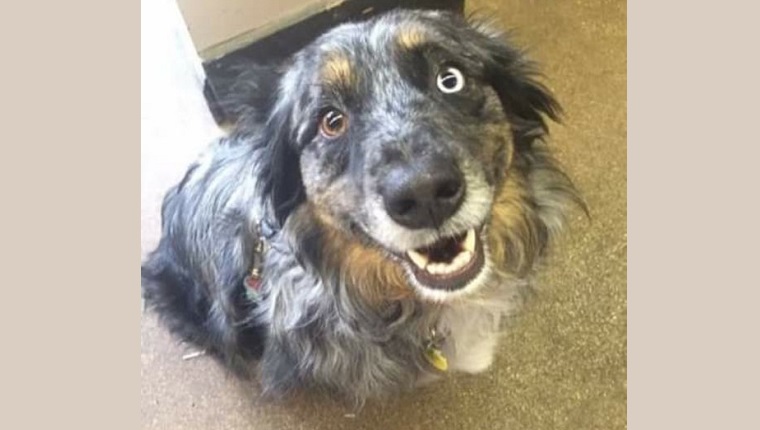
AMANDA: I believe you mentioned a library. What do you guys do there?
LEE: Nowadays, I work at Summit Public Library, helping in circulation, programming, all different areas.
Our favorite activity is the weekly service dog presentation we do with Java Beans, reading the children’s book Ally’s Busy Day about service dogs, and then introducing Java Beans to all the kids.
It’s a wonderful, enriching event for them, especially learning about that at such a young age. We also visit preschools and do this program. Now, with the coronavirus, we are doing online events.
AMANDA: That’s really awesome. Kudos to you for educating kids on this important topic at such a young age. I bet they love it! You do education/public speaking for adults, too, don’t you?
LEE: Thank you, and yes, I do! I do a lot of speaking at hospitals, especially about the patient experience, and much of this is through the Spinal Cord Injury Association of Illinois. I have a passion for helping others by sharing my experience and knowledge.
AMANDA: Lee, you are an incredible human being, and it is an honor to know you! I’m glad I got to meet you and Merlot, all those years ago! Thank you so much for sharing your story with us.
For more information about the Spinal Cord Injury Association of Illinois, please visit their website.
Do you rely on a service dog? Have you had any similar experiences to the ones Lee has had? Let us know in the comments below!
